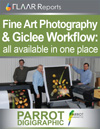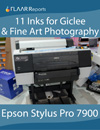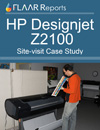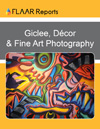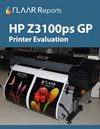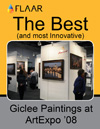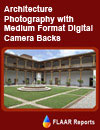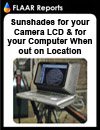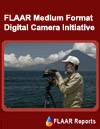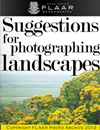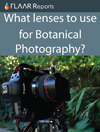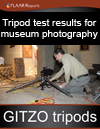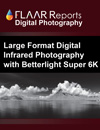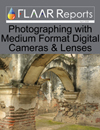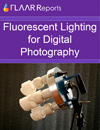Long range evaluation of digital cameras for photographing architecture
Three of us from FLAAR Reports went to Photokina to look at all the cameras that were available to photograph architecture. Our goal was to make a short-list of the best three architectural cameras, and then to select which one we would evaluate.
At Photokina you could find booths of Alpa, Arca-Swiss, Cambo, Linhof, and Sinar. Many other brands did not have a booth so were hard to find. If a company is not large enough to have a booth, I would question whether they are large enough to develop new camera systems. I don't want a camera conceived twenty years ago, and even less a camera developed 30 years ago.
I will be writing a page on each camera brand, but the short list was Cambo Wide, Sinar arTec, and Arca-Swiss Rm3d1. The Cambo contenders were:
- Cambo Wide RS
- Cambo Wide DS
- Cambo Wide Compact
 |
| Nicholas Hellmuth with Rene Rook at the Cambo factory. |
Which camera for digital photography of architecture?
 |
| Nicholas Hellmuth at the Cambo booth at Photokina 2010. |
 |
| Cambo camera shown at Photokina 2010. |
 |
| Cambo camera at Photokina 2008. |
 |
| Cambo camera at Photokina 2006. |
There must be lots of architectural photographers willing to spend substantial sums on highly specialized cameras. There are already for several years many excellent dedicated wide-angle cameras by Cambo, Silvestri and now by Sinar, Alpa and Arca-Swiss. Horseman was also copying these earlier models and tried to enter this market several years back. But recently evidently the owner of Horseman passed away and none of their cameras were at Photokina 2010.
Gottschalk shift cameras used to be exhibited at Photokina, but I did not see this company at Photokina 2004 nor at Photokina 2006 and not at Photokina 2008 either. At Photokina 2010 I was there for five days, and did not see their cameras anywhere, though their Gottschalk web site says they were in someone else's booth (but if I am looking for this kind of camera and don't notice it in five days, it's hard to judge that it's worth for a company like Gottshalk skipping having your own booth).
Do not confuse these Cambo and related architectural cameras with roll-film wide-angle cameras from two decades ago, such as Fuji, Linhof, or Japanese copies such as Horseman. Those require 120 or 220 roll-film and do not accept a medium format digital back. Yes, Cambo Wide DS accepts film; most of these cameras do, but increasingly these cameras, such as the model Cambo Wide RS, are exclusively made for medium format digital backs. I will admit that I have not used any film since I first tested a Kodak DCS 420 circa 1997 and became beta tester for Better Light large-format digital backs circa 1998.
In distinction the wide-angle shift cameras were made primarily for 4x5 sheet film and thus can accept a sliding back adapter so you can use a medium format digital back from Leaf, Hasselblad, Jenoptik, MegaVision, Phase One, Sinar, or other brands.
Architectural background
I have been photographing architecture since age 16, when I first stood in front of an 8th century Mayan temple pyramid at Palenque, Chiapas, Mexico, with a Leica camera in my hand. This was year 1961. I was by myself as a backpacker; the hotel in the village cost 50 cents a night. There were at most seven tourists at Palenque that day.
The photos I took in Chiapas, Mexico, I used in my high school thesis; it won 1st prize; that got me into Harvard, where I continued to practice photography courtesy of E. Philip Levine camera company (who provided me Leica and Hasselblad cameras at a reasonable price since I was still a student).
Thirty years later I was photographing Mayan temple-pyramids with a 4x5" Linhof and an 8x10" Linhof for a Japanese coffee table book (I worked for 18 months in Mexico, Guatemala, Belize, Honduras, and El Salvador doing the photography for this book).
When first writing this web page, as we entered 2011, I have been photographing Mayan architecture with digital cameras since at least 1999, using first a Better Light tri-linear scanning camera, a Nikon, and then using a Phase One P25+ and Canon EOS-1Ds Mark III.
Today (in 2019) I use a Nikon D5 and Canon EOS ID X Mark II. But I am tempted to return to Phase One (the past era of Hasselblad superiority has long been overtaken by Phase One and Leaf, now both joined into Phase One)
 |
| Temple I at Tikal photographed by Nicholas Hellmuth with Phase One P25+ |
Comparing medium-format with 35mm DSLR such as Canon EOS?
Canon Incorporated would prefer that people skip medium format cameras and buy only a Canon EOS-1Ds Mark III. The entire camera costs less than a single large-format lens for a 6x9 cm format architectural camera. But I prefer to use all three:
- Canon EOS-1D Mark III (we just got a 14mm non-fisheye lens)
- Hasselblad medium format with Phase One P25+ digital back
- 6x9 "large-medium format" Cambo WIDE RS
Each of these cameras has several benefits. No one format is perfect for all situations. But in general, a medium format can out-perform a 35mm camera, but a 35mm camera is more portable and significantly less expensive. It just depends which you prefer: excellence in a remarkable photo (medium format), or a good photo but 35mm. Both formats will look great in an exhibit. But on the computer monitor and in your own heart, you recognize the medium format is a richer image.
Deciding which large-medium-format architectural camera to select
Lots of cameras are available to choose from:
- Alpa 12 XY
- Cambo Wide DS, Cambo Wide RS
- Arca-Swiss Rm3d1
- Linhof M 679cc, 679cs, Linhof Techno
- Sinar arTec
The Alpa would probably do well in a FLAAR evaluation but is too expensive. FLAAR is a research institute dedicated to testing and evaluating digital camera equipment for architectural and architectural history photography. We respect Swiss technology but frankly after I saw the Cambo factory in Holland, I realized that the Cambo was well engineered and could produce a fully professional quality photograph. I would like to evaluate the Alpa, but the price was out of question. I realize that some of the people who read the FLAAR Reports can afford an Alpa, but most of our readers would tend to select a camera that was top quality but reasonable price.
Arca-Swiss is a well made camera but when I tried to telephone and e-mail them I never get any answer. I have asked others and heard the same thing: they often simply don't answer e-mail or even telephone calls. I don't have time to waste for this kind of company style. But Arca-Swiss owners are pleasant in their booth at Photokina.
Sinar arTec was really tempting, but Sinar has gone through what might most politely be described as restructuring (someone even said they went bankrupt or close to bankruptcy about two or three years ago). Plus their accessories are very expensive. But mainly, the person I knew at Sinar America, Jack Ridley, is no longer there, so I had no one at Sinar to contact.
Linhof is a respected brand name: I have a Linhof 8x10 (their absolute top of the line model) and also I have used a Linhof Technikardan for many years. But when I got my Cambo cameras, they did not wobble like the Technikardan. The Cambo was more rigid for using with a Better Light scanner back. I then got a Cambo sliding back adapter. I am also satisfied with this. So I am content with Cambo cameras. Since they know FLAAR and the FLAAR Reports, it is easier to interact with Cambo personnel at Photokina and when I was near their factory, an invitation to visit them was instant.
Cambo always replies to e-mails; Cambo replies to telephone calls. And Cambo follows up when they say they will do something.
Cambo BV is a larger company than I expected
A visit to the world headquarters of Cambo was worth the time and the train fare. First, the company is larger than I expected. Second, they clearly have experience with how to design, engineer, and manufacture precision equipment.
I have also visited Silvestri near Florence (about a month before visiting Cambo). And about ten years ago I visited Seitz in Switzerland (where now the Alpa is also manufactured).
I have also visited Phase One in Denmark (about eight years ago).
This kind of reconnaissance is what sets FLAAR Reports apart from sham reviews, and pseudo-reviews. We at FLAAR actually study the cameras, and, as often as is possible, we test the cameras out in the real world. We will begin testing the Cambo Wide DS as soon as we can obtain the selected Rodenstock lenses: Rodenstock HR Digaron-W 32 mm f/4 and Rodenstock HR Digaron-W 70mm f/5.6.
Most recently updated August 20, 2019.
First posted December 21, 2010.
Free Reports (Inquiry Form)
Additional links of our FLAAR sites |
| Rigid Printable Materials |
| Printing on Glass |
| Sandwich board for recyclable furniture! |
| Metallic Effects |
Free Download Reports
| Home | About Us | Consulting | About FLAAR Reports | Site Map | Privacy Statement | back to top | |||||
|
|||||||||||
www.digital-photography.org is part of the FLAAR network © 2001-2021. If you notice a bad link, missing photos, misspellings, please report to the webmaster: |
|||||||||||



